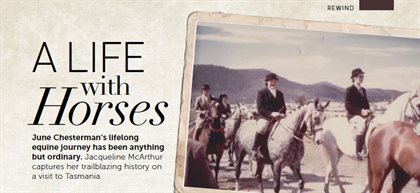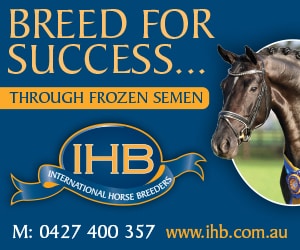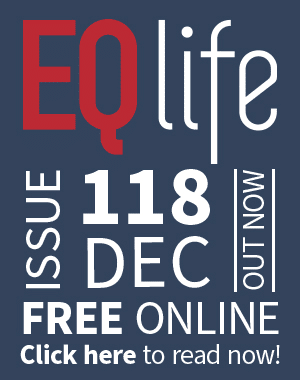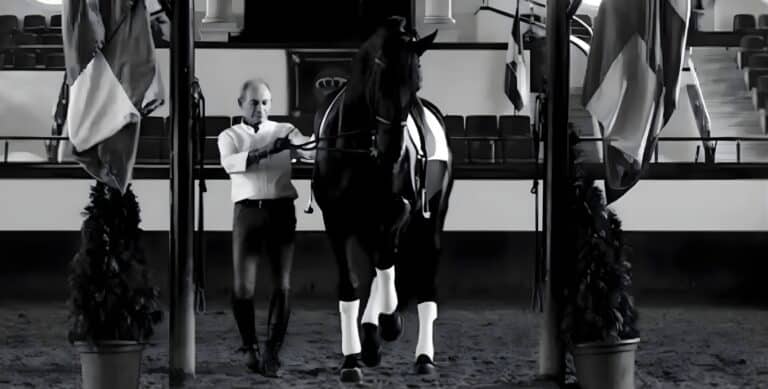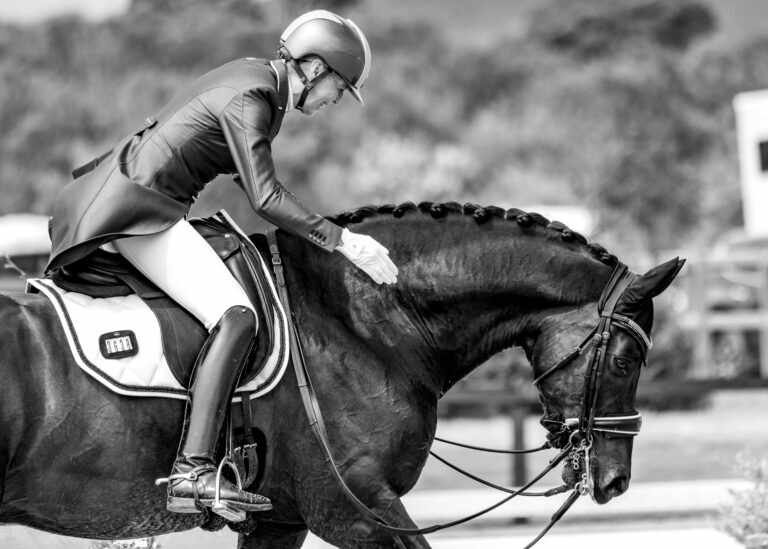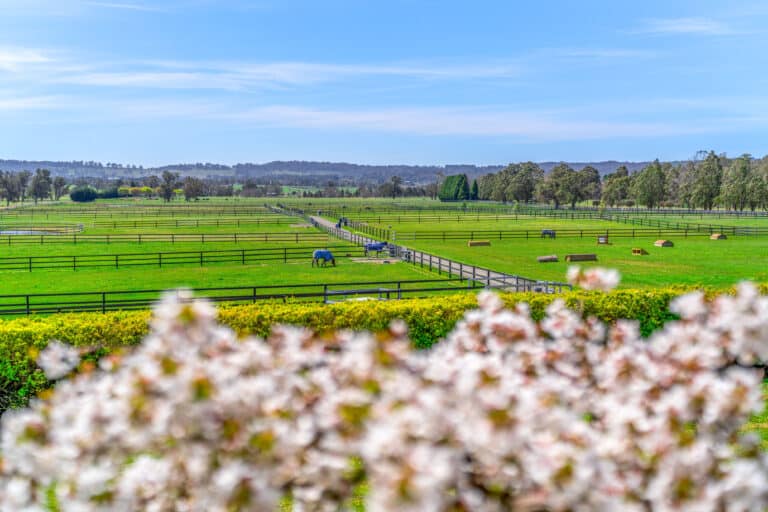This article has appeared previously with Equestrian Life. To see what is in our latest digital issue, please click here.
A Life with Horses
Equestrian Life express their sincere condolences on the recent passing of Australia’s first FEI International Dressage Judge, June Chesterman, from Tasmania. Here, we take a look back on an article about June from the Equestrian Life archives…
By Jacqueline McArthur
June Chesterman’s lifelong equine journey has been anything but ordinary. Jacqueline McArthur captures her trailblazing history on a visit to Tasmania.
There is a little known idyll on the east coast of Tasmania where on sunny days the sea resembles a slick of fast- flowing mercury. a series of violet-
coloured silhouettes, the mountains of Maria island, f rame the mesmerising shimmer. it is glorious to watch and difficult to leave.
June Chesterman rode along fine white beaches for many years, surveying these silvery tides. her secluded sheep property, Earlham, was three hours by rough rain- forest track and precipitous roads from Hobart.
How the peripatetic pioneer of Australian dressage made it from there to Aachen’s city of white tents, the Hong Kong Jockey Club’s floodlit equine metropolis or dusty dressage arenas on the South African veldt, is a tale worth telling.
It starts with an adventurous little girl who refused to dismount from the Melbourne Zoo’s famous elephant, Queenie and ends with a letter from a Princess – a most unwanted correspondence. But, more of that later.
As the first Australian to become a Fédération Equestre Internationale (FEI) dressage judge and a member of the Equestrian Federation of Australia (EFA), June left her isolated Tasmanian beach on hundreds of occasions to circumnavigate Australia and the world.
She became a dressage selector for the World Championships and Olympic Games and a well-known fixture for more than three decades at Hobart, Perth, Melbourne and Adelaide royal shows.
June attended the World Dressage Championships in Canada, Sweden and Germany. She judged in England, South Africa, Hong Kong, New Zealand, Sweden and all states of Australia.
“Tasmania is to Australia what Australia is to the world, both surrounded by a moat. But, you choose to see it as a long distance or not,” she says.
The Tasmanian horsewoman’s white 1974 Mercedes, similar to James
Bond’s tricked-up conveyance in The Man With the Golden Gun, travelled
tens of thousands of kilometres via land and sea. In the boot was a small flask of emergency whiskey, a shooting stick, picnic rug, binoculars and a judge’s notebook.
Brenda Atkinson, a long time travelling companion and co-founder of the
Tasmanian Dressage association, says of June: “she was always so generous with her time, she never refused to judge at any of the little Tasmanian events. She never missed the Campbell Town competition and other shows. June would judge any class and officiated at three day events and driving championships.”
But, it wasn’t all work, Brenda says. “June is full of fun, life was never dull around her.”
It also wasn’t a one-way trek around winding roads and ‘vertical curves’ from the Chesterman’s base near Orford. Many people enjoyed parties and picnics at Earl- ham, most of them involving a pot of pink-eye potatoes, lamb chops, rock cakes and that unforgettable view of the Mercury Passage.
Often among the picnickers was comedian, Barry Humphries – June liked Dame Edna better than Sir Les Patterson, but preferred Barry himself. “He was a very nice friend, not many people knew it but he was humble and well-mannered. Extremely funny of course.”
It’s a quality they shared. There are several reports of June’s clinic attendees holding onto their pommels lest they fall off laughing at her jokes and asides. She has a roaring laugh herself, famous among competitors and judges across the country.
Born in the leafy Melbourne suburb of Kew in 1918, June Burgess grew up at a time when horses were an important part of daily life to the majority of Australians. Country people went on hunts, played polo and polocross, attended rodeos, competed in camp drafting, flag racing, hacking events and picnic races.
In the city, horses came to the door on Tuesdays and Fridays delivering milk, meat and bread.
As a nimble eight–year old June commandeered the long-suffering fruit and vegetable deliveryman’s horse as it ambled down Toorak’s Albany road. (“he was never in a hurry, you couldn’t catch the baker’s horse – he was flat out,” June says).
“I was given my first pony for Christmas when I was ten – sadly it was the first family economy at the beginning of the Great Depression,” she recalls.
“However, I had trained hard on the naughty shetland and achieved the seven necessary falls. I eventually rode well enough to graduate to bigger horses straight from the racetrack and jumped over the hurdles at Caulfield racecourse.”
An 18hh thoroughbred called Ironside proved risky business for June after he rolled the wrong way and tipped her into the Yarra. But, her favourite horse was a superb arabian mare given to her great uncle by a sheik he had entertained while visiting Australia.
“I was the only one who could manage her – she was called something unpronounceable in Arabic so we nicknamed her Dainty Doll, I adored her,” June says.
One day as she rode on the Tan, the perimeter track of Melbourne’s royal Botanic Gardens, she encountered the Duke of Gloucester who had been staying at Government house. “Well, it would catch your eye – a teenage girl on a great big thoroughbred,” June says.
Riding and horses featured heavily on winter visits to her family’s sheep stations around Cunnamulla, in southeast Queensland and summer visits to Tasmania.
The Burgess family’s sandstone summer home, Boweravine, at Moonah was accompanied by a stand of horse chestnuts, a paddock and stables with views of Hobart’s Cornelian Bay.
June met and married Tasmanian, Rupert Chesterman, as war broke out, fell ardently in love with the untouched east coast, purchased Earlham and raised four children. There was little time for horses.
She began riding again when her three daughters Julia, Caroline, and
Victoria were old enough to get on and stay on, a horse.
The large retinue of horses began with ‘Fat Chops’ – a Timor shetland, of unknown provenance and grumpy demeanour adept at wiping children off on branches and unseating them onto hard Tasmanian turf.
The others were anglo-arabs then thoroughbreds with names inspired
by the pantry. Cinnamon, Chutney, Capers, Cheddar, Candycane, Catsup and
Carroway were ferried around in floats from one end of Tasmania to the other.
When the children were older, Rupert delivered horses and children in an old red international truck to various shows and gymkanas. June followed in the cream Oldsmobile crammed with tack and clothes, saddles in the back.
Between shows, a governess cart (much like strawberry punnet on wheels and full of children) was dragged around Hobart’s Queens Domain by the unreliable Fat Chops – “a miserable coot of a creature”.
Two catalysts arrived to send June off on the international dressage circuit after her children had grown up and left Earlham’s paddocks pony-free.
The first was the death of her husband Rupert when June was just 53. The second was a fateful riding seminar with a gentle Austrian horseman.
Franz Mairinger had been educated at the prestigious Cavalry school of Hanover, where he trained in show jumping and three day eventing. He became a senior instructor at the Spanish riding school in Vienna for 12 years before RM Williams noticed his exceptional handling of both horses and humans. The famous bush outfitter sponsored Mairinger’s migration to Australia. He went on to coach Australia’s Olympic equestrian teams for decades and inspire generations of equestrian competitors and judges.
“Franz revolutionised Australian riding. When I had my first lesson with him, I realised I didn’t know anything about horses and I had been riding all my life,” June says. “Dressage was not a word in Australian riders’ vocabulary.”
“We learned which leg came after the other and I was fascinated with every aspect of it and how much more pleasurable dressage was.”
Franz was June’s teacher for 20 years. She attended all of his schools in
Tasmania and many seminars across the country.
“I used every opportunity to pencil at competitions, course-watch or
gate-keep at any place I could,” she says. “I studied hard from books and asked many, many questions.”
Among her notes about dressage judging is this central observation: “submission does not mean a crushing subservience but an obedient horse shown by harmony, lightness, attention, willingness and gay confidence.” When the royal patron of the FEI, Princess Anne and June met in Tasmania at the 1989 Hobart show, both were sporting the same gold galloping equine brooch. June’s had a girth of diamonds while the princess’ a diamond mane. “I would have given him a bit of grooming if I’d known he was going to meet a royal stablemate,” June laughed later.
Princess Anne and June talked about the international judging circuit – a favourite place for both was the Hong Kong Jockey Club. “We didn’t say anything about the brooches, but while we were talking we had our eyes on each other’s horses,” June says.
Three years later, June retired reluctantly from international dressage judging after receiving a letter from Princess Anne thanking her for her contribution. The FEI had just placed an age limit on judges, regardless of their fearless propensity for travel or acuity of mind. June was only 73.
“When a judge decides they know it all, then it is the time to give up judging,” she wrote to her colleagues.
The EFA life membership badge is a rare piece of jewellery and one June holds dear. The letter accompanying her badge reads: “… it serves as a reminder of all the good times and great people who worked with you to make the EFA what it is today.”
When June was made Patron of the Dressage association of Tasmania, her colleagues wrote to her with similar warmth: “Your acceptance of this position would be the most appropriate recognition of the many years you have dedicated to furthering the interests of dressage within this state, in particular your very special contribution as a judge at the highest level of the sport.”
Now comfortably living in Hobart after a lifetime’s worth of travelling, June often returns to Earlham when she can to survey the quicksilver seas beside her home. She still finds it glorious to watch and difficult to leave.
READ THE LATEST NEWS ARTICLES HERE
